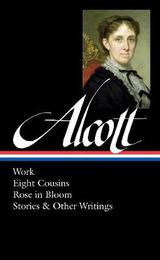
|
Louisa May Alcott: Work, Eight Cousins, Rose in Bloom, Stories & Other Writings
Hardback
Main Details
| Title |
Louisa May Alcott: Work, Eight Cousins, Rose in Bloom, Stories & Other Writings
|
| Authors and Contributors |
By (author) Louisa May Alcott
|
|
Edited by Susan Cheever
|
| Physical Properties |
| Format:Hardback | | Pages:900 | | Dimensions(mm): Height 206,Width 132 |
|
| Category/Genre | Classic fiction (pre c 1945) |
|---|
| ISBN/Barcode |
9781598533064
|
| Classifications | Dewey:813.4 |
|---|
| Audience | |
|---|
|
Publishing Details |
| Publisher |
The Library of America
|
| Imprint |
The Library of America
|
| Publication Date |
28 August 2014 |
| Publication Country |
United States
|
Description
After the success of her beloved masterpiece Little Women, Louisa May Alcott brought her genius for characterisation and eye for detail to a series of revolutionary novels and stories that are remarkable in their forthright assertion of women's rights. This second volume of The Library of America's Alcott edition gathers these works for the first time, revealing a fascinating and inspiring dimension of a classic American writer.
Author Biography
Louisa May Alcott (29 November 1832 - 6 March 1888) was born in Germantown, Pennsylvania. When she was almost two years old, Louisa's family moved to Massachusetts, the state where she lived for much of her life. The family moved many times over the years, usually back and forth between Boston and Concord (Mass.). Some notable places Louisa lived were 'Fruitlands' in Harvard, Massachusetts; 'Hillside' in Concord; and 'Orchard House,' also in Concord. 'Fruitlands' was the site of her father's attempt at Utopian living, which she wrote about in Transcendental Wild Oats, thirty years later in 1873. Louisa's childhood at 'Hillside' (later renamed 'Wayside' by Nathaniel Hawthorne, when he lived there) served as the basis for the action in her most popular novel, Little Women, which she wrote as an adult living in 'Orchard House.' Interestingly, these latter two houses were located next door to each other, with a walking path through the woods between. They are both still standing and open for tours in Concord. Louisa May Alcott's father, Amos Bronson Alcott, was an important - though controversial - man in his times and in his community. He is perhaps best known for being a philosopher and an education reformer, but he was also a leader in the Transcendentalist movement as well as a teacher, school superintendent, and an author. He established both the Temple School, in Boston, and the Concord School of Philosophy. Although he was a loving father, he was not very responsible or practical, so Louisa's mother, Abigail May Alcott, filled the role of 'head of household'. Just like Jo, the protagonist in her Little Women, Louisa had three sisters - one older (Anna Bronson Alcott) and two younger (Elizabeth 'Lizzie' Sewall Alcott and Abba May Alcott). And, much like Jo's sister Beth, Lizzie died at age 22 from complications of scarlet fever. But, unlike Jo, Louisa also had a little brother, who died as an infant. Louisa May Alcott was a versatile writer who started at an early age. At the encouragement of her father, she kept a diary as a child - which probably helped her to discover her love and talent for writing and surely provided ideas later for her various plots and characters. As a teenager, Louisa wrote several plays, poems, and short stories. She achieved publication for the first time at age nineteen, with a poem entitled 'Sunlight' (1851), which she wrote under the pseudonym, 'Flora Fairfield.' The title of Ms. Alcott's first published short story was The Rival Painters- A Tale of Rome (1852), and her first published book was Flower Fables (1854), a collection of short fairy-tale stories and poems which she had originally created to entertain Ralph Waldo Emerson's daughter Ellen. Louisa May Alcott wrote her first novel, The Inheritance, at age seventeen, but it went unpublished for nearly 150 years until 1997, after two researchers (Joel Myerson and Daniel Shealy) stumbled across the handwritten manuscript in the Houghton Library at Harvard University. Of course, Ms. Alcott is best known for a different novel, Little Women, which she wrote in two parts. The first volume, alternately titled Meg, Jo, Beth, and Amy, was published in 1868, and the second volume, Good Wives, was published in 1869. Like Jo in Little Women, Louisa also wrote many 'blood and thunder' tales, which were published in popular periodicals of the day. She did not openly claim authorship for many of these Gothic thriller stories, however- for some, she used the pseudonym, 'A. M. Barnard'; for others, she chose to remain completely anonymous. Louisa May Alcott's career was not restricted to writing. Beginning in her late teens, she worked as a teacher for several years and off-and-on as a seamstress. In December of 1862, at age 30, she traveled to Washington, DC, to serve as a Civil War nurse at the Union Hotel Hospital in Georgetown. The following year, she re-wrote her letters detailing that experience, to form Hospital Sketches, which was published first serially and then as a book. And, in the winter of 1867/68, Ms. Alcott became the editor of Merry's Museum, a children's magazine. Louisa Alcott also was an avid social reformer. Abolition, temperance, and educational reform were among her chosen causes. But being a feminist at heart, she especially fought for women's rights, including suffrage. In fact, she was the first woman to register to vote in Concord. Unlike Jo in her Little Women, Louisa May Alcott never married. She died at age 55 on March 6, 1888, (two days after her father) and is buried on 'Authors' Ridge' in Concord's Sleepy Hollow Cemetery, with her family. Nearby are the graves of her friends and mentors Ralph Waldo Emerson, Nathaniel Hawthorne, and Henry David Thoreau.
|